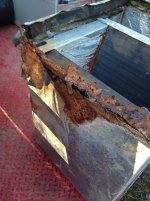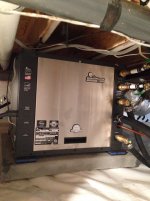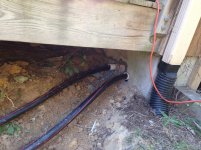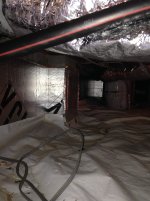Country Geek
Gold Member
I didn't really do a good job of keeping up with this but I did want to close it out. They finished the install and turned on the geothermal system on Friday, November 14th. That night the temperature plunged and we've had several mornings of temps below 20 degrees since then. The system has loafed along, it easily kept the house at 70 degrees with no aux heat used (I know no aux heat was used because I have it set up so I have to manually turn it on). I still don't regret getting the aux heat because my main reason was to have something I could run off a generator during ice storm power outages.
As part of this project I also had the crawlspace encapsulated. It was a mess down there because critters had figured out how to pull off the crawlspace vents and had been getting under there during cold weather, and tearing up the fiberglass insulation and the flexible ducts to nest in the material. The encapsulation guys found a skeleton of the possum down there, as well as plenty of other mess that you can expect where wild animals live. I also had a top-end whole house air cleaner installed (Trane CleanEffects) and the cumulative effect of the encapsulation and air cleaner is like a new house. Bad odors in the house that I thought were caused by my pets literally disappeared overnight. Allergies and minor respiratory problems also disappeared virtually overnight. I can't recommend this enough!
Some pictures:

This is the old condenser coil, showing the rust and mold that results from being in a vented crawlspace in a humid southern climate, for 15 years. Yuck, we were breathing that!

The Geothermal compressor in the crawlspace. Notice the plastic below, the rubber mounts, and no insulation between the floor joists (because the crawlspace is now sealed and insulated)

Geo lines going into the crawlspace. They did not bore directly into the crawlspace because there are so many piers under there they were concerned about how deep they'd have to go and getting the lines up into there without doing any damage. So they bored to about 5 feet from the crawlspace and then hand dug a trench to the crawlspace wall and punched it in there.

This picture gives an idea of what the crawlspace encapsulation entailed. You can see the plastic on the ground that goes up the wall behind the R-10 insulation board that is attached to the block wall of the crawlspace. The very top is left uncovered for termite inspection.
As part of this project I also had the crawlspace encapsulated. It was a mess down there because critters had figured out how to pull off the crawlspace vents and had been getting under there during cold weather, and tearing up the fiberglass insulation and the flexible ducts to nest in the material. The encapsulation guys found a skeleton of the possum down there, as well as plenty of other mess that you can expect where wild animals live. I also had a top-end whole house air cleaner installed (Trane CleanEffects) and the cumulative effect of the encapsulation and air cleaner is like a new house. Bad odors in the house that I thought were caused by my pets literally disappeared overnight. Allergies and minor respiratory problems also disappeared virtually overnight. I can't recommend this enough!
Some pictures:

This is the old condenser coil, showing the rust and mold that results from being in a vented crawlspace in a humid southern climate, for 15 years. Yuck, we were breathing that!

The Geothermal compressor in the crawlspace. Notice the plastic below, the rubber mounts, and no insulation between the floor joists (because the crawlspace is now sealed and insulated)

Geo lines going into the crawlspace. They did not bore directly into the crawlspace because there are so many piers under there they were concerned about how deep they'd have to go and getting the lines up into there without doing any damage. So they bored to about 5 feet from the crawlspace and then hand dug a trench to the crawlspace wall and punched it in there.

This picture gives an idea of what the crawlspace encapsulation entailed. You can see the plastic on the ground that goes up the wall behind the R-10 insulation board that is attached to the block wall of the crawlspace. The very top is left uncovered for termite inspection.
